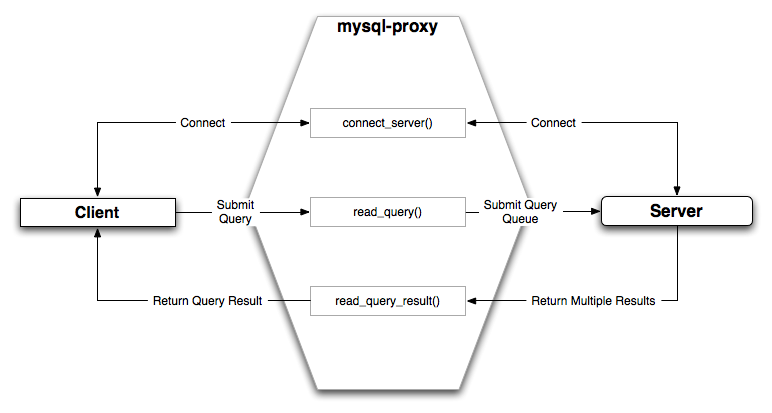- 6.4 MySQL Proxy Scripting
- 6.4.1 Proxy Scripting Sequence During Query Injection
- 6.4.2 Internal Structures
- 6.4.3 Capturing a connection with connect_server()
- 6.4.4 Examining the handshake with read_handshake()
- 6.4.5 Examining the authentication credentials with read_auth()
- 6.4.6 Accessing authentication information with read_auth_result()
- 6.4.7 Manipulating Queries with read_query()
- 6.4.8 Manipulating Results with read_query_result()
The figure below gives an example of how the proxy might be used when injecting queries into the query queue. Because the proxy sits between the client and MySQL server, what the proxy sends to the server, and the information that the proxy ultimately returns to the client do not have to match or correlate. Once the client has connected to the proxy, the following sequence occurs for each individual query sent by the client.

The client submits one query to the proxy, the
read_query()function within the proxy is triggered. The function adds the query to the query queue.Once manipulation by
read_query()has completed, the queries are submitted, sequentially, to the MySQL server.The MySQL server returns the results from each query, one result set for each query submitted. The
read_query_result()function is triggered for each result set, and each invocation can decide which result set to return to the client
For example, you can queue additional queries into the global query queue to be processed by the server. This can be used to add statistical information by adding queries before and after the original query, changing the original query:
SELECT * FROM City;
Into a sequence of queries:
SELECT NOW(); SELECT * FROM City; SELECT NOW();
You can also modify the original statement, for example to add
EXPLAIN to each statement
executed to get information on how the statement was processed,
again altering our original SQL statement into a number of
statements:
SELECT * FROM City; EXPLAIN SELECT * FROM City;
In both of these examples, the client would have received more result sets than expected. Regardless of how you manipulate the incoming query and the returned result, the number of queries returned by the proxy must match the number of original queries sent by the client.
You could adjust the client to handle the multiple result sets
sent by the proxy, but in most cases you will want the existence
of the proxy to remain transparent. To ensure that the number of
queries and result sets match, you can use the MySQL Proxy
read_query_result() to extract the
additional result set information and return only the result set
the client originally requested back to the client. You can
achieve this by giving each query that you add to the query
queue a unique ID, and then filter out queries that do not match
the original query ID when processing them with
read_query_result().
